|
|
|
Sort Order |
|
|
|
Items / Page
|
|
|
|
|
|
|
| Srl | Item |
| 1 |
ID:
157925
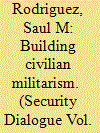

|
|
|
|
|
| Summary/Abstract |
In late 2016, the Colombian government and the Revolutionary Armed Forces of Colombia signed a peace agreement to bring an end to an internal war in Colombia that had lasted more than 50 years. During this process, pro-military attitudes within Colombian society that called for a hardline solution and rejected the peace agreement were highly visible, revealing the extent to which militarism had been embedded in Colombia over the years. This embedding of militarism had been enabled by the country’s many years of chaos and the use of counterinsurgency forms of warfare, which over the years had led civilian elites to adopt a militaristic approach to countering threats. In this article, I will examine key issues related to the central role of militarism and militarization in the scenario of violence and insecurity in Colombia, drawing on mid- and short-term historical perspectives, to highlight what I refer to as the country’s ‘civilian militarism’. First, I discuss how the main conceptual framing regarding militarism, militarization, and security applies to the Colombian case. Second, I describe and analyze the origin of civilian militarism in the context of the struggle between Colombia’s traditional political parties, and the militarization of the police and the intertwining of its role with that of the army as a legacy of that time. Third, I briefly examine how various presidential programs have embedded the concept of security in the 1990s and thereafter, though this is seen as a façade to enable the unfolding of a military approach to countering threats over the years, and how mandatory military service was used until recently as a tool to bolster support for militarism among everyday people.
|
|
|
|
|
|
|
|
|
|
|
|
|
|
|
|
| 2 |
ID:
091499
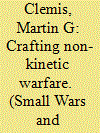

|
|
|
|
|
| Publication |
2009.
|
| Summary/Abstract |
Written in response to the ongoing insurgencies in Iraq and Afghanistan, the new US Army/Marine Corps counterinsurgency manual reflects a unity of effort between the military and academic worlds rarely seen at the doctrinal or operational level. Because counterinsurgency operations are predicated upon an intimate understanding of human behavior as well as the social, economic, and political forces that can aggravate and encourage insurgents to take up arms against the standing authority, the American military has called upon scholars to lend their expertise towards developing nonmilitary or 'nonkinetic' prescriptions for battling 'internal' war over the years. Since the early 1960s many within the academic community have answered that call. Such participation, however, has sparked a bitter debate among members of both academe and the military. This article will examine the role that human rights advocates and social scientists have played in shaping counterinsurgency doctrine as well as the controversy this participation has produced both during the Cold War and today.
|
|
|
|
|
|
|
|
|
|
|
|
|
|
|
|
| 3 |
ID:
128227
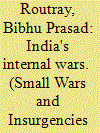

|
|
|
|
|
| Publication |
2013.
|
| Summary/Abstract |
The continued incapacity of the central police forces remains an important reason behind persistent failures of India to deal with the challenge posed by violent extremists. Despite past successes, police-led counterinsurgency responses in the country's internal wars remain riddled with problems. Years of experience in being deployed in conflict-affected areas and considerable numerical strength notwithstanding, the central police forces have failed to emerge as able security providers. Decades of neglect, a slow modernisation process, a vacuum in leadership, and recurrent command and control problems continue to hamper building the country's counterterrorism architecture around these men in uniform.
|
|
|
|
|
|
|
|
|
|
|
|
|
|
|
|
| 4 |
ID:
131301
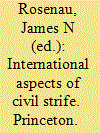

|
|
|
|
|
| Publication |
Princeton, Princeton University Press, 1964.
|
| Description |
vii, 322p.Hbk
|
| Contents |
B
|
|
|
|
|
|
|
|
|
|
|
|
Copies: C:1/I:0,R:0,Q:0
Circulation
| Accession# | Call# | Current Location | Status | Policy | Location |
| 057789 | 341.39082/ROS 057789 | Main | On Shelf | General | |
|
|
|
|
| 5 |
ID:
078959
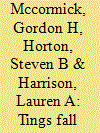

|
|
|
|
|
| Publication |
2007.
|
| Summary/Abstract |
Most internal wars end on the battlefield. Only a small percentage end at the negotiating table. While significant attention has been paid to how internal wars begin and how they evolve, relatively little attention has been paid to how they are concluded. What research has been done on this subject, furthermore, has focused almost exclusively on the problems that stand in the way of achieving a negotiated outcome, not on how these conflicts are so frequently resolved by force. This article examines the dynamics of the endgame struggle and the quite different ways in which states and insurgencies 'win' and 'lose' internal wars. We explore this topic theoretically and empirically in the first part of the article and examine the formal logic of the endgame in the second part, explaining how and why these endings follow a predictable pattern
|
|
|
|
|
|
|
|
|
|
|
|
|
|
|
|
| 6 |
ID:
132820
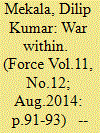

|
|
|
|
|
| Publication |
2014.
|
| Summary/Abstract |
If asked, ministry of home affairs (MHA) downplays this, but India's internal security battle is being fought by the most disgruntled, demotivated paramilitary troops. The reason for such a shameful situation is the inaction by the ministry in resolving the grievances of the forces. FORCE has interacted with many officers below Commandant rank deployed in operational positions, who claim that the weak leadership is to be blamed entirely for the situation.
MHA has often painted a rosy picture that all is well within the forces. Even in the Parliament recently, while explaining the reason behind huge number of Central Reserve Police Force (CRPF) officers quitting their jobs, the ministry stated that it is "normal and acceptable". From 2009 to 2012, in the CRPF alone 16,523 officers quit their jobs. What is more baffling is the casual tone of reasoning that the ministry has provided in justifying this issue. "The causative factors in most of the cases were mainly found to be various personal and domestic reasons… Some personnel seek voluntary retirement to enjoy a static life as well as pensionary benefits after completion of 20 years of regular service," said minister of state (home), Kiran Rijiju.
What MHA conveniently did not state in the reply to the Parliament is that most of the officers who quit their jobs were troubled by their uncertain career progression - they believed that no due credit was given for risking their lives in conflict zones. Poor salary also caused a lot of dissatisfaction. Presently, there are at least 10,000 officers from all paramilitary forces fighting various legal cases in the courts, thus proving that all's not well within.
|
|
|
|
|
|
|
|
|
|
|
|
|
|
|
|
| 7 |
ID:
076507
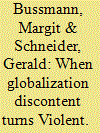

|
|
|
|
|
| Publication |
2007.
|
| Summary/Abstract |
One of the disputed consequences of global economic integration is the possible effect that foreign economic liberalization exerts on social cohesion. Proponents of commercial liberalism see stabilization as an indirect consequence of growing economic interdependence, while globalization critics are much more skeptical. They expect, at least during the liberalization process, destabilizing effects. We examine in this paper the contradictory claims in the light of what we call the distributional theory of civil war. This variant of commercial liberalism qualifies the peace-through-trade hypothesis and expects, based on political economy models of trade policy making, that the redistributive struggle associated with foreign economic liberalization can culminate in violent forms of protest. We demonstrate that a higher level of economic openness is indeed associated with a lower risk of civil war. At the same time, economic liberalization increases the chances of instability weakly. None of the following factors are found to exert any compensatory influence on instability: social spending, foreign aid, and financial flows from the International Monetary Fund. Discontent over the process of globalization is thus a destabilizing force despite the pacifying effect that the level of economic integration exerts.
|
|
|
|
|
|
|
|
|
|
|
|
|
|
|
|
|
|
|
|
|